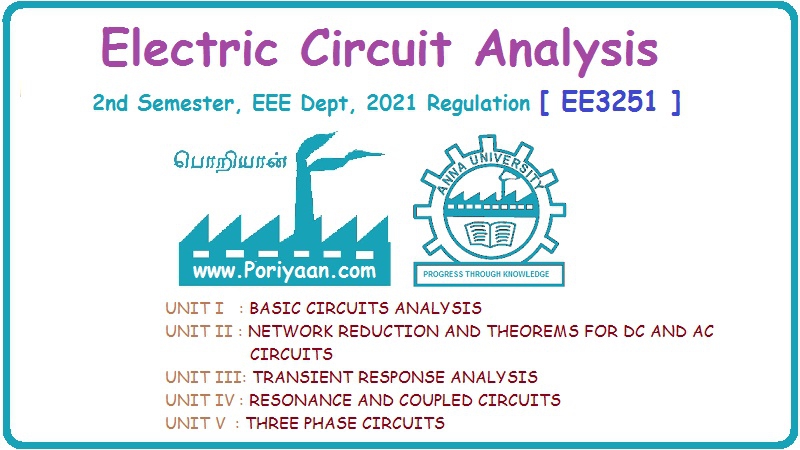Electric Circuit Analysis: Unit I: b. Basic circuits analysis
Worked examples on series-parallel circuits
Solved Example Problems with Circuit Diagram, Equation
Electric Circuit Analysis: Unit I: Basic circuits analysis : Worked examples on series-parallel circuits
WORKED EXAMPLES ON
SERIES-PARALLEL CIRCUITS
Example
1 Find the voltage across R1 and R2

Also find the value of R3
Solution:
For understanding easily the given circuit can be re-drawn as shown below:
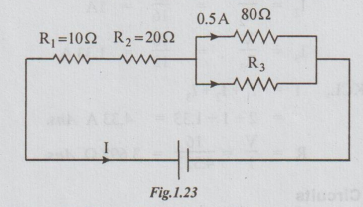
By
Ohm's law, Voltage across 80Ω = 40 volts
As 80 Ω and R3 are in parallel, VR3
= 40 volts
i.e.,
Voltage across R3 = 40 volts
Let
the equivalent of parallel combination of 80 and R3 be Rp.
Hence
the circuit becomes as
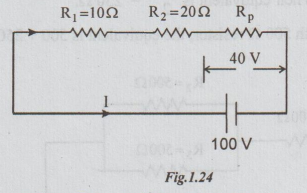
voltage
across (R1 + R2) = 100 - 40 = 60 volts
i.e.,
I[R1 + R2] = 60 volts
I
= 60/ R1+R2 = 60/10+20 = 2A
By
ohm's law VRI = IR1=2 ×10=20 volts
VR2
= IR2 = 2 × 20 = 40 volts
By
KCL, I = 0.5+IR3
⇒ IR3 = I-0.5 =
2-0.5 = 1.5A
R3
= VR3/IR3 = 40/1.5
= 26.7Ω
Ans:
(i)
VR1 = 20volts
(ii)
VR2= 40volts
(iii)
R3 = 26.7 Ω
Example
2 Find V in the circuit in fig. 1.25
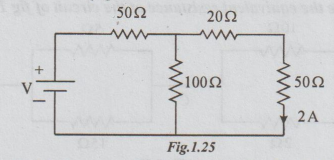
Solution:
Re-drawing the circuit given, we obtain the following fig. 1.25
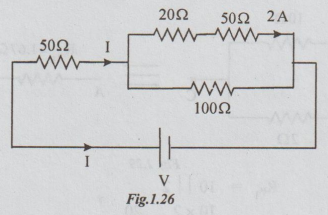
Given
that, I20 = I50 = 2A
By ohm's law, V20 = I20
× 20 = 2× 20 = 40 volts
And
V50= I50 × 20 = 2 × 50 =100 volts
V20
+ V 50 = 40 + 100 = 140 volts
⇒ V70 = 140
volts
As
100 Ω and (20+ 50) are in parallel.
V100
= V70 = 140
⇒ By ohm's law, I100
= 140/100 = 1.4A
By
KCL, I= I100 +I70 = 1.4 +2 = 3.4 A
Let
RP be the equivalent of parallel combination of 70 and 100Ω
Rp
= 70 × 100/ 70 + 100 = 41.2 Ω

50
Ω and 41.2 are in series.
Rtotal
= 50 + 41.2 = 91.2 Ω
V
= IRtotal
=
3.4 × 91.2
=
310 volts
Ans
: V = 310 volts
Example
3 Determine the equivalent resistance of the circuit of fig 1.28. between A and
B.
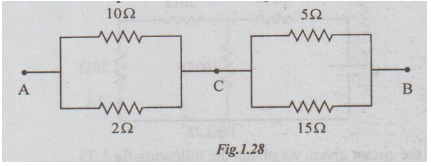
Solution:
Step: 1

RP2
= 10 || 2
=
10 × 2/10 + 2 = 20/12
=
1.67Ω
Step:
2
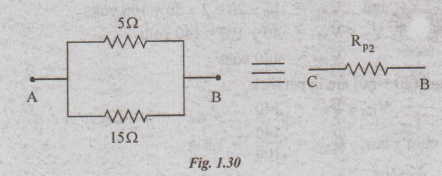
RP2
= 5||15 = 5×15/5 + 15 = 3.75Ω
Step
3: RP1 and RP2 are in series,
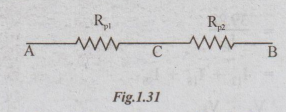
RAB
= RAC + RCB =RP1+ RP2=1.67
+3.75
Ans:
RAB = 5.42 Ω
Example
4 A circuit consisting of three resistances 12 Ω 18Ω and 36Ω respectively
joined in parallel is connected in series with a fourth resistance. The whole
circuit is applied with 60 V and it is found that the power dissipated in the
12Ω resistor is 36 W. Determine the value of the fourth resistance and the
total power dissipated in the circuit.
Solution:
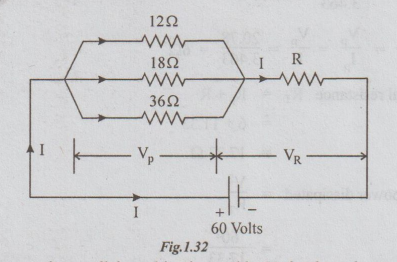
Let
VP be the voltage across the parallel combination and let VR
be the voltage across R.
Given
that power dissipated in 12 Ω = 36 watts.

VP
= √36 × 12 = 20.78 volts.
VR
= 60-20.78
= 39.22 volts
For
R, applying ohm's law,
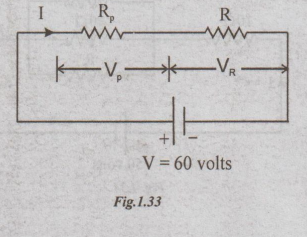
Substituting
IR in (iii),
R
= 39.22 /3.463 = 11.33Ω
and
RP = Vp/IP = VP/I = 20.78/3.463 = 6Ω
Total resistance RT = RP +
R
=
6 + 11.33
=
17.33Ω
Total
power dissipated = V2/RT
=
602/17.33
=
208 watts
Ans:
(i)
R = 11.33Ω
(ii) Total power dissipated = 208 watts
Example
5 Determine the value of R if the power dissipated in 10 ohm resistor is 40 W
for the circuit shown.
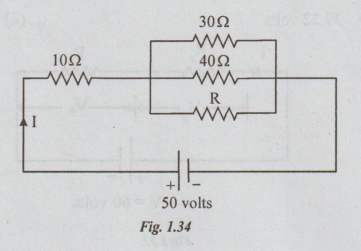
Solution:

Example
6 The current in the 6Ω resistor of the network shown in the figure is 2A.
Determine the currents in all other resistors and the voltage Vacross the
network.
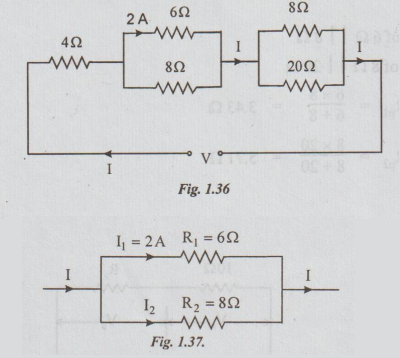
Solution:
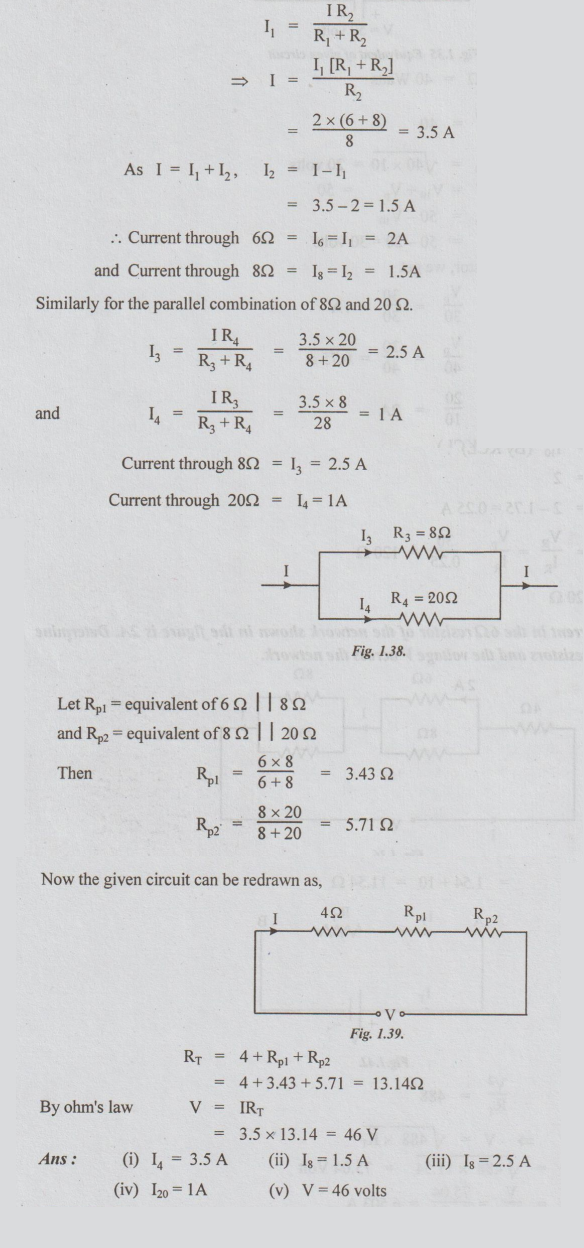
Example
7 In the circuit shown in the fig, the total power dissipated is 488 watts. Determine
the current in each resistor and the p.d between A and B.
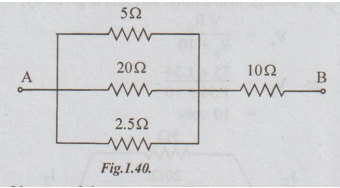
Solution:
Let
V = p.d. between A and B
and
RT = total resistance between A and B
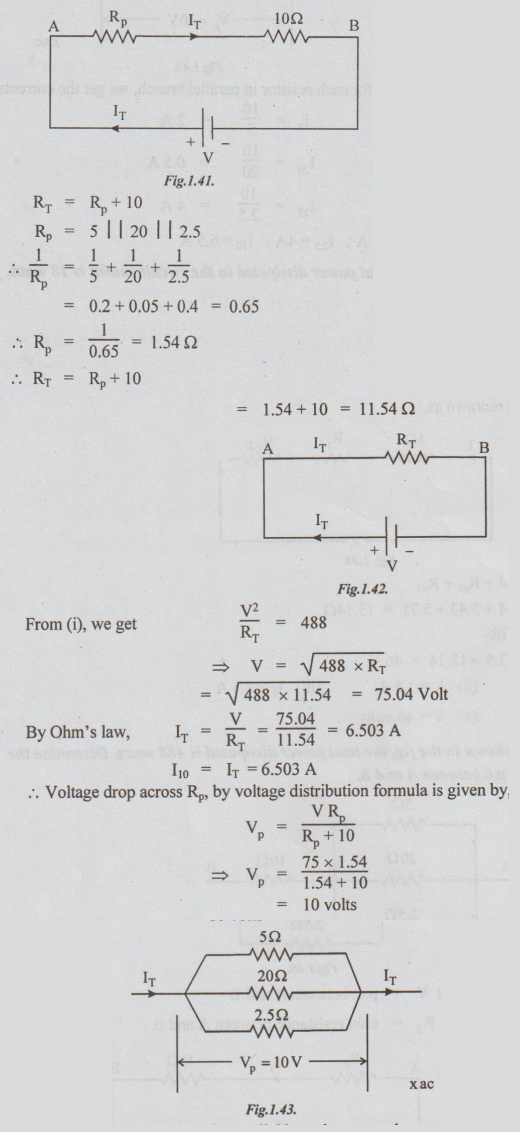
By
applying ohm's law for each resistor in parallel branch, we get the currents as
follows:
I5
= 10/5 = 2A
I20
= 10/20 = 0.5A
I25
= 10/2.5 = 4A
Ans:
15 = 2A; I20 = 0.5 A; I25 = 4A; I10
= 6.5 A
Example
8 If the total power dissipated in the circuit shown is 18 watts, find the
value of R and current through it.
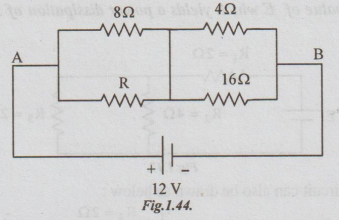
Solution:
The given circuit can be re-drawn as shown below, for better understanding
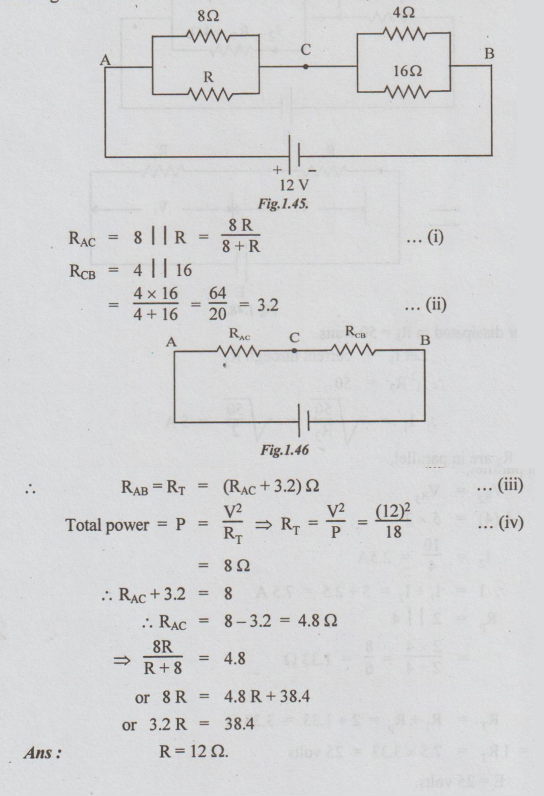
Example
9 Find the value of E which yields a power dissipation of 50W in R3 of the
following circuit.
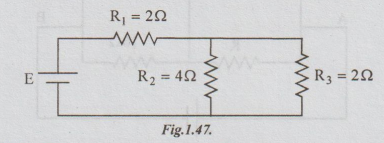
Solution:
The
original circuit can also be drawn as below:

Example
10 Two coils connected in parallel across a 100 v.d.c. supply draw a total
current of 9A. The power dissipated in one resistor is 500 watts. Find the
resistance of two coils and current in each coil.
Solution:
Data:
V
=100 volts
I
= 9A
P1
= 500 watts
R1
and R2 are in parallel.
RT
= V/I = 100/9 = 11.11Ω ...(a)
R1
R2/R1+ R2 = 11.11
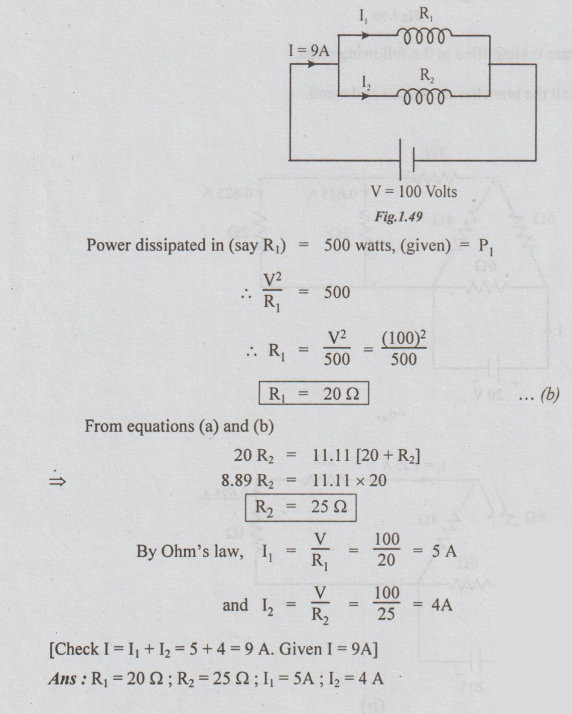
Example
11 Find the current supplied by the source in the circuit shown in the fig.
Also determine the power in each resistor.
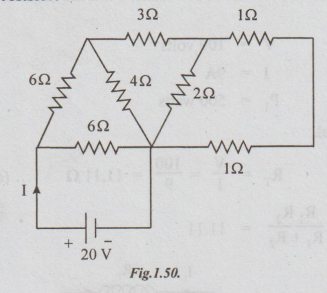
Solution:
The
circuit diagram is simplified in the following steps.
Note:
The
currents in all the branches are shown at the end.
Step
1:
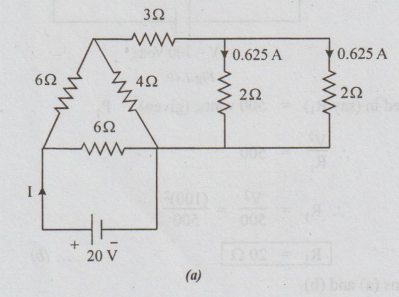
Step
2:
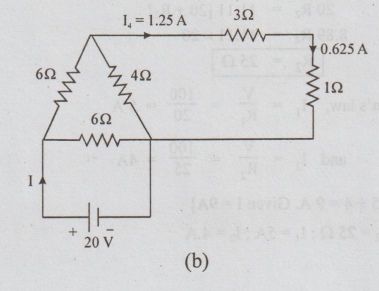
Step
3:

Step
4:
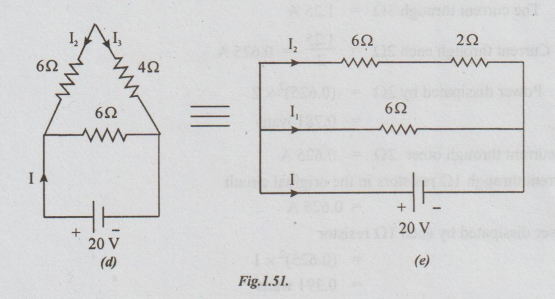
Step
5: Fig.1.53 (e), I1 = 20/6 = 3.33A
I2
= 20/8 = 2.5A
I = I1+I2
=
3.33+2.5
=
5.83A
Power
dissipated in 6Ω = I12 × 6
=
(3.33)2 × 6
=
66.53 watts
The
power dissipated in another 6Ω resistor
=
I22 × 6
=(2.5)2
× 6
=
37.5 watts
Represent
I2 in figs 1.53 (d) and (c)
Refer
fig (c), 4Ω and 4Ω are in parallel [equal-resistances]
I4
= I2/2 = 2.5.2
=
1/25A
Power
dissipated in 4Ω = (1.25)2 × 4 = 6.25 W
Current
through another 4Ω =1.25 A
Transfer
this current to the fig (b). Refer fig. (b).
Current
through 3Ω = I4
Power
dissipated by 3Ω= (1.25)2×3=4.6875 watts.
See
the 30 in fig (a).
The
current through 3Ω = 1.25A
Current
through each 2Ω = 1.25/2=0.625A
Power
dissipated by 2Ω = (0.625)2 × 2 = 0.781 watts.
The
current through other 2Ω = 0.625 A
Current through 1Ω resistors in the original
circuit = 0.625A
Power dissipated by each 122 resistor
=
(0.625)2 × 1= 0.391 watts
Answers
as tabulation:
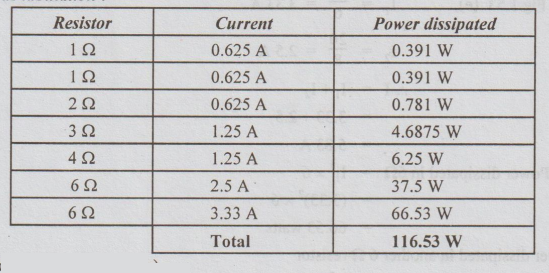
Note: For the circuit in fig. (e),

Check:
Sum of power dissipated by all resistors = 116.53 watts
Example
12 Calculate the equivalent resistance of the following combination of
resistors and also the source current.
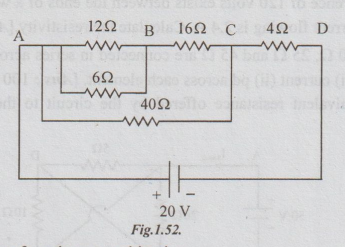
Solution:
Start
simplifying from inner combination.
Step
1: Replace parallel combination of 12 and 6Ω to get the following circuit.
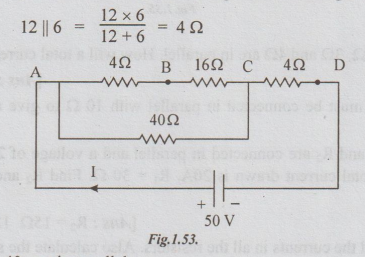
Step
2: (4+16) and 40 are in parallel.
Their
equivalent resistance is =20 × 40/20 + 40 =13.3 Ω
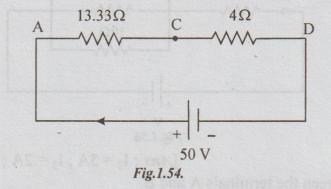
Step
3: 13.33 and 4 are in series.
RT
= RAB = 13.33 +4
=17.33
Ω
Step
4: I = source current
=
V/ RT = 50/17.33 = 2.885 A
Ans:
(i) RT = 17.33Ω ; (ii) Source current I = 2.885 A
Electric Circuit Analysis: Unit I: b. Basic circuits analysis : Tag: : Solved Example Problems with Circuit Diagram, Equation - Worked examples on series-parallel circuits
Related Topics
Related Subjects
Electric Circuit Analysis
EE3251 2nd Semester 2021 Regulation | 2nd Semester EEE Dept 2021 Regulation
